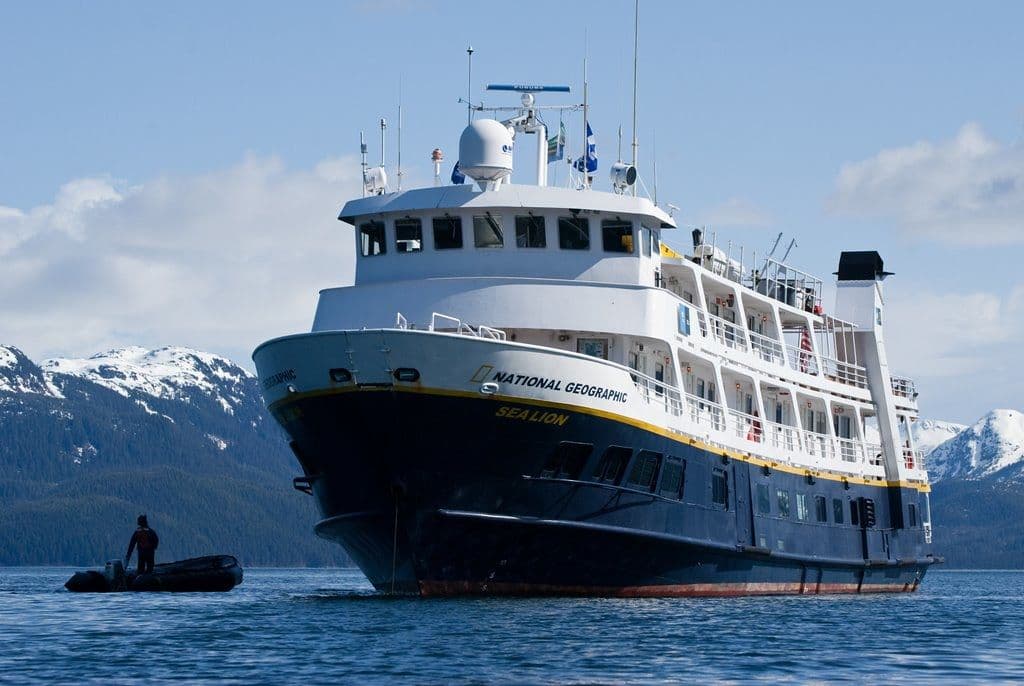Overview
630
Gross Tonnage
62
Guest Capacity
1982
Year Built
N/A
Last Refit
?
Crew Ratio
Since its launch in 1982 and its latest refurbishment in 2015, the National Geographic Sea Lion has seamlessly blended the thrill of exploration with the comfort of travel. This expedition-focused vessel, catering to 62 travelers per journey, provides a unique and intimate cruise experience at a premium price point. Its smaller guest capacity not only fosters a more personal atmosphere but also allows access to secluded destinations that larger cruise ships cannot reach, providing guests with unparalleled encounters with nature and wildlife.
At its core, the National Geographic Sea Lion is dedicated to offering more than just a cruise; it promises an adventure. With a clear focus on immersive experiences rather than lavish entertainment or ornate decorations, the ship prioritizes hands-on adventures and educational enrichment. Accompanied by a team of experienced naturalists, undersea specialists, and certified photo instructors, guests are guaranteed to not only witness but truly comprehend the beauty of destinations such as Alaska, Costa Rica, Panama, and the Pacific Northwest. Activities like kayaking in tranquil coves, hiking through verdant trails, and making Zodiac landings for up-close wildlife observations are hallmarks of the experience. Moreover, the ship's agility to modify its itinerary in pursuit of remarkable wildlife encounters highlights its dedication to delivering extraordinary moments.
The typical demographic aboard the Sea Lion includes retired, well-educated individuals who are passionate about environmental conservation. The informal and communal atmosphere onboard is reminiscent of an adult summer camp, encouraging communal dining and collective explorations that cultivate a sense of camaraderie among passengers. Although the ship's smaller size may limit the variety of public spaces, guests often remark on the cozy and focused environment, which promotes active engagement and learning over passive amusement.
When compared to other vessels in the Lindblad Expeditions-National Geographic fleet and the wider cruise industry, the National Geographic Sea Lion occupies a unique niche. Its compact size permits in-depth exploration of remote natural territories that larger, amenity-packed ships cannot approach. However, this advantage does come with certain compromises, such as simpler dining options and accommodations. Additionally, the absence of traditional cruise entertainment and amenities might not appeal to those in search of a conventional luxury cruise experience.
In conclusion, the National Geographic Sea Lion excels in its mission to deliver a cruise experience centered on expedition and education, bringing guests closer to the natural world and various cultures in a meaningful way. It offers an exceptional opportunity for travelers eager to dive into the marvels of off-the-beaten-path destinations, under the guidance of experts and within a like-minded community. For those with a passion for exploration and environmental appreciation, the Sea Lion presents a voyage experience unlike any other, albeit with an understanding that it differs from the conventional luxury cruise offering.
Pros
- Intimate experience with quiet coves and up-close animal encounters due to the ship's small size.
- Access to tiny fishing villages and remote areas inaccessible to larger vessels.
- Onboard naturalists and Nat Geo-certified photo experts ensure a rich educational experience.
- Flexible itineraries accommodate last-minute changes for wildlife sightings and weather conditions.
Cons
- Limited public spaces due to the ship's small size.
- No elevator, making it unsuitable for passengers with mobility issues.
- Most cabins have twin beds; limited options for couples desiring double beds.
- Higher cost compared to big-ship cruises, without traditional luxury amenities.
Tips
- Bring versatile clothing layers for varying weather conditions, especially for Alaska sailings.
- Pack your own binoculars for personal wildlife viewing; the ship provides them for onboard use only.
- Participate in the evening talks by naturalists to deepen your understanding of the destinations.
- Take advantage of the photography expert onboard to improve your nature and wildlife photography skills.
- Book meals earlier or later than peak times to enjoy quieter dining experiences.
- Fill out the breakfast sign-up sheet to help the kitchen prepare and reduce food waste.
- Explore the ship's observation areas for spontaneous wildlife sightings.
- Interact with the crew and other passengers; the communal atmosphere is part of the expedition cruise experience.
- If prone to seasickness, prepare accordingly with medication; smaller ships feel more movement.
- Embrace the expedition spirit by being flexible and open to itinerary changes based on natural occurrences.
